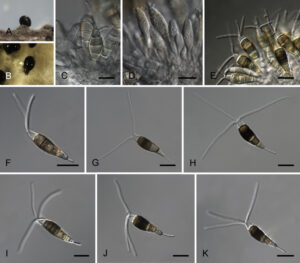Neopestalotiopsis formicidarum Maharachch., K.D. Hyde & Crous [as ‘formicarum’], in Maharachchikumbura, Hyde, Groenewald, Xu & Crous, Stud. Mycol. 79: 140 (2014) (Figure 5).
Index Fungorum number: IF 821673; MycoBank number: MB 821673; Facesoffungi number: FoF 10804;
Etymology – Named after the insect host family from which it was isolated, Formicidae.
Saprobic on rotting tree axis of Dypsis leptocheilos. Sexual morph: not observed. Asexual morph: Conidiomata (on PDA) pycnidial, globose to clavate, solitary or aggregated in clusters, semi-immersed, brown to black, 200–500 μm diam; exuding globose, dark brown conidial masses. Conidiophores reduced to conidiogenous cells. Conidiogenous cells discrete, ampulliform to lageniform, hyaline, smooth, thin-walled, simple, proliferating several times percurrently, 3–10 × 2–5 μm, apex 1–3 μm diam. Conidia ellipsoid, straight to slightly curved, 4-septate, (20–)21–28(–29) × 7.5–9.5 μm, x̄ ± SD = 24.6 ± 1.4 × 8.6 ± 0.4 μm; somewhat constricted at septa; basal cell conic to acute with truncate base, rugose and thin-walled, 4.5–6 μm long; three median cells (14–)15–16.5(–17) μm long, x̄ ± SD = 15.1 ± 1 μm, doliiform, verruculose, versicoloured, brown, septa darker than the rest of the cell (second cell from base pale brown, 4–6.5 μm long; third cell dark brown, 4–6 μm long; fourth cell brown, 4.5–6.5 μm long); apical cell subcylindrical, hyaline, thin- and smooth-walled, 4–5.5 μm long; with 2–3 tubular apical appendages, arising from the apical crest, flexuous, unbranched, (20–)23–33(–36) μm long, x̄ ± SD = 27 ± 4 μm; basal appendage single, tubular, unbranched, centric, 4–8 μm long.
Culture characteristics – Colonies on PDA reaching 30–40 mm diam after 7 d at 25 °C, edge undulate, whitish to pale honey-coloured, with moderate aerial mycelium on the surface, with black, gregarious conidiomata; reverse similar in colour.
Habitat – On dead ants and plant debris.
Known distribution – Cuba and Ghana.
Material examined – Cuba, from plant debris, 1982, sent to CBS for ident. by G. Arnold (via W. Gams), CBS H-15752, culture CBS 115.83. Ghana, from dead ant (Formicidae), Nov. 1971, H.C. Evans (CBS H-15661, holotype, ex-type culture CBS 362.72).
Notes – Neopestalotiopsis formicarum (clade 11; Fig. 4) is a saprobic species collected from dead ants in Ghana and plant debris from Cuba. This species is a sister taxon to N. clavispora and Neopestalotiopsis sp. Clade 10 (clades 12 and clade 10, respectively; Fig. 4). It differs from N. clavispora in having larger conidia and longer apical appendages.

Figure 1 – Neopestalotiopsis formicarum CBS 362.72T. A. Conidiomata sporulating on PNA. B. Conidiomata on PDA. C–E. Conidiogenous cells. F–K. Conidia. Scale bars = 10 μm.
